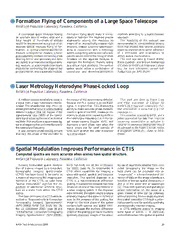
NASA Technical Reports Server (NTRS) 20090008412: Laser Metrology Heterodyne Phase-Locked Loop PDF
Preview NASA Technical Reports Server (NTRS) 20090008412: Laser Metrology Heterodyne Phase-Locked Loop
Formation Flying of Components of a Large Space Telescope NASA’s Jet Propulsion Laboratory, Pasadena, California A conceptual space telescope having Formation flying would make it unnec- methods according to a leader-follower an aperture tens of meters wide and a essary to maintain the required precise approach. focal length of hundreds of meters alignments among the modules by The feasibility of the concept was would be implemented as a group of six means of an impractically massive rigid demonstrated in computational simula- separate optical modules flying in for- structure. Instead, a control system oper- tions that showed that relative positions mation: a primary-membrane-mirror ating in conjunction with a metrology could be maintained to within a fraction module, a relay-mirror module, a focal- system comprising optical and radio sub- of a millimeter and orientations to plane-assembly module containing a fast systems would control the firing of small within several microradians. steering mirror and secondary and terti- thrusters on the separate modules to This work was done by Edward Mettler, ary optics, a primary-mirror-figure-sens- maintain the formation, thereby acting Marco Quadrelli, and William Breckenridge ing module, a scanning-electron-beam as a virtual rigid structure. The control of Caltech for NASA’s Jet Propulsion Labora- module for controlling the shape of the system would utilize a combination of tory. For more information, contact iaof- primary mirror, and a sunshade module. centralized- and decentralized-control [email protected]. NPO-45199 Laser Metrology Heterodyne Phase-Locked Loop NASA’s Jet Propulsion Laboratory, Pasadena, California A method reduces sensitivity to noise in the output of the zero-crossing detector. This work was done by Frank Loya a signal from a laser heterodyne interfer- Because the PLL output is an oscillator and Peter Halverson of Caltech for ometer. The phase-locked loop (PLL) re- signal, it is glitch-free. This enables the NASA’s Jet Propulsion Laboratory. Fur- moves glitches that occur in a zero-crossing ability to make accurate phase measure- ther information is contained in a TSP detector’s output [that can happen if the ments in spite of low SNR, creates an im- (see page 1). signal-to-noise ratio (SNR) of the hetero- munity to phase error caused by shifts in This invention is owned by NASA, and a dyne signal is low] by the use of an internal the heterodyne frequency (i.e. if the tar- patent application has been filed. Inquiries oscillator that produces a square-wave sig- get moves causing Doppler shift), and concerning nonexclusive or exclusive li- nal at a frequency that is inherently close to maintains a valid phase even when the cense for its commercial development should the heterodyne frequency. signal drops out for brief periods of be addressed to the Patent Counsel, NASA It also contains phase-locking circuits time, such as when the laser is blocked Management Office–JPL. Refer to NPO- that lock the phase of the oscillator to by a stray object. 40080. Spatial Modulation Improves Performance in CTIS Computed spectra are more accurate when scenes have spatial structure. NASA’s Jet Propulsion Laboratory, Pasadena, California Suitably formulated spatial modula- NASA Tech Briefs, Vol. 26, No. 11 (Novem- By use of algorithms adapted from com- tion of a scene imaged by a computed- ber 2002), page 7a. To recapitulate: A puted tomography, the image on the tomography imaging spectrometer CTIS offers capabilities for imaging a focal plane can be processed into an (CTIS) has been found to be useful as scene with spatial, spectral, and temporal “image cube” — a three-dimensional col- a means of improving the imaging per- resolution. The spectral disperser in a lection of data on the image intensity as a formance of the CTIS. As used here, CTIS is a two-dimensional diffraction function of the two spatial dimensions (x “spatial modulation” signifies the im- grating. It is positioned between two relay and y) in the scene and of wavelength position of additional, artificial struc- lenses (or on one of two relay mirrors) in (λ). Thus, both spectrally and spatially re- ture on a scene from within the CTIS a video imaging system. If the disperser solved information on the scene at a optics. were removed, the system would produce given instant of time can be obtained, The basic principles of a CTIS were de- ordinary images of the scene in its field of without scanning, from a single snapshot; scribed in “Improvements in Computed- view. In the presence of the grating, the this is what makes the CTIS such a poten- Tomography Imaging Spect rometry” image on the focal plane of the system tially powerful tool for spatially, spectrally, (NPO-20561) NASA Tech Briefs, Vol. 24, contains both spectral and spatial infor- and temporally resolved imaging. No. 12 (December 2000), page 38 and mation because the multiple diffraction A CTIS performs poorly in imaging “All-Reflective Computed-Tom ography orders of the grating give rise to multiple, some types of scenes — in particular, Imaging Spectrometers” (NPO-20836), spectrally dispersed images of the scene. scenes that contain little spatial or spectral NASA Tech Briefs, January 2009 29
